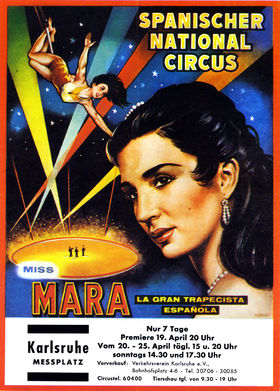Miss Mara
From Circopedia
Aerialist
By Dominique Jando
María Papadopoulos Vaquero was born in 1934 in San Fernando, in the province of Cádiz, Spain, to Miro Papadópulos Stavanovich, who had Greek ancestry but came from a Romanian family, and his wife, Canela Remedios Vaquero. María was the firstborn of a large family, and all her life, she would assume a kind of matriarchal responsibility for her siblings, including her brother Antonio, who, as a celebrated acrobat on tight wireA tight, light metallic cable, placed between two platforms not very far from the ground, on which a wire dancer perform dance steps, and acrobatic exercises such as somersaults. (Also: Low Wire), was known as Tonito.
Mara, as she became known, made her debut in the ring in 1939, at age five. She performed in Cartagena as part of the family circus, Circo Florida. A very strong girl, both physically and psychologically, Mara developed a remarkable trapeze act in which she did most of her work swinging—not a very common presentation at the time. Her tricks included heel-catches, neck-hangs, and a heel-catch in full swing, which was a specialty of the great Australian trapeze artist Winnie Colleano. Mara worked at dizzying heights, without any safeguards.
Mara's act was exceptional for its time. In April 1945, the famous Spanish circus impresario, Juan Carcellé, noticed her at the Feria of Seville, where Circo Florida was performing. Three years later, when Miro Papadopoulos sold his circus to his brother, Cristóforo Cristo, Mara was free to strike out on her own. It was the beginning of a rich and brilliant international career.
International Star
Mara was contracted by Circo Segura, where she struck a lifelong friendship with Cristina Maria del Pino Segura, better known as Pinito del Oro, another legendary aerialistAny acrobat working above the ring on an aerial equipment such as trapeze, Roman Rings, Spanish web, etc.. It was during her time with Circo Segura that she first fell from her trapeze, incapacitating herself for a month.
In 1949, Mara embarked on her first international tour, traveling first to Portugal, then to the south of France. On March 4, 1950, in Seville, she married Enrique Campo Muñoz. Their union was to last 18 years. In October of the same year, she signed a contract with Ringling Bros. and Barnum & Bailey, The Greatest Show On Earth, then in its final Golden Age under the inspired direction of John Ringling North.
On March 1, a month and a half before making her U.S. debut at Madison Square Garden, Mara had given birth in Seville to her only child, Enriqueta. Mara would eventually spend six years in the U.S., but on September 11, 1953, in Tacoma, Washington, she fell again—this time with very serious consequences. She had to undergo no less than seven surgeries. Still, on March 4, 1955, she returned to Ringling with her original act unchanged.
Back to Spain
Mara returned to Spain in December 1957. She began working at Circo Americano. The largest traveling circus in Spain at the time, Circo Americano was under the management of the powerful impresarios Manuel Feijóo and Arturo Castilla, who together also ran the venerable Circo Price in Madrid. She worked for Feijóo-Castilla in several of their ventures (Circo Americano, Circo Price, and Spanischer National Circus with Carola Williams) both in Spain and abroad through 1963. In that year, she received the Oscar Internacional del Circo, which was awarded annually for several years by the International Circus Federation, a circus organization controlled by Arturo Castilla.
After that, Mara worked with her uncle, Cristofóro Cristo, at his Circo Berlin. She toured extensively throughout Europe, flying from time to time to the U.S., where she appeared on television in the Ed Sullivan show. She even made it all the way to Australia.
In 1976, with her brother, Tonito, Mara participated in the third International Circus Festival of Monte Carlo. Having been awarded a special prize, rather than the coveted Gold or Silver Clown, Miss Mara, who was in her way a true circus diva, refused to participate in the final Gala Performance.
Miss Mara eventually retired from performing in 1979, at the end of a season with Circo Atlas, one of Spain's major circuses, which was owned by Spain's most celebrated clowns, Manolo and José Villa, better known as the Hermanos Tonetti.
Retirement and Awards
In 1992, the Spanish government awarded Mara its Premio Nacional del Circo (National Circus Award). Mara had immense charisma and a powerful personality, not to mention outstanding talent. Hers remained, until the 1970s, among the greatest trapeze acts the circus had ever seen. Remarkable trapeze performers such as Isabella Nock, Judy Merton, and more recently, Silvia Zerbini have since continued in her footsteps.
By the late 1980s, Russian trapeze artists, beginning with Elena Panova, transformed the character of the swinging trapeze, deemphasizing danger in favor of increasingly elaborate tricks. This transformation was made possible in part by the generalized use of safety devices. Still, in her time, the flamboyant Maria Papadópulos reigned supreme over the trapeze world. Miss Mara passed away on December 14, 2013 in Madrid, where she had retired. She was seventy-nine. She will always been remembered as "La Mara," as she was often called—one of the truly great circus performers of the twentieth century.
See Also
- Video: Miss Mara, at the Spanisher National Circus (1962)
Suggested Reading
Simón González, Una Vida apasionante en la Barra del Trapecio (Madrid, Ed. J. García Verdugo, 1999) ISBN 84-95144-23-9


